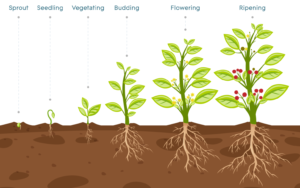Back to: Basic Technology Primary 3
Welcome to class!
In today’s class, we’re going to embark on an adventure into the fascinating world of plant growth and irritability. Yes, you read that right—plants can be irritable in their own unique way! Let’s explore how these incredible beings grow and respond to the world around them.
Understanding Plant Growth

Plants have some amazing growth abilities:
Cell Division: Just like us, plants are made of cells. They can grow by dividing their cells, making new ones to add to their structures.
Photosynthesis: Plants use a process called photosynthesis to convert sunlight into energy. This energy fuels their growth. They need water, carbon dioxide, and sunlight for this magical process to happen.

Roots and Shoots: Plants have two main parts: roots and shoots. Roots anchor the plant in the ground and absorb water and nutrients. Shoots grow upward toward the sun and produce leaves, flowers, and fruits.
Growth Hormones: Plants produce hormones, like auxins, that control growth. These hormones tell the plant where to grow and when to make more roots, stems, or leaves.
Plant Irritability – Sensing the World
Plants can sense and respond to their environment, a unique trait known as irritability:
Phototropism:

This is when plants respond to light. For example, sunflowers turn their faces to follow the sun as it moves across the sky. This helps them get the most sunlight for photosynthesis.
Geotropism: Plants also respond to gravity. Roots grow downward, and shoots grow upward because of this response. This way, they can find water and sunlight more effectively.
Thigmotropism: Some plants can sense touch. For instance, if you touch the leaves of a sensitive plant, they’ll quickly fold up as a response.
Chemical Signals: Plants can release chemicals to warn nearby plants about threats, like insect attacks. This is like sending a distress signal to neighbors!
Today, we’ve learned that plants grow by cell division, use photosynthesis to make energy, have roots and shoots, and produce growth hormones. They can also sense their environment through phototropism, geotropism, thigmotropism, and chemical signals.
Evaluation
How do you think understanding plant growth and irritability can help us in gardening, farming, or even in protecting plants in the wild? Share your thoughts with me in our next class!
Classwork
Choose a plant, and observe its growth over a few weeks. Measure how much it grows, and notice any changes in the direction of its leaves or stems. Try touching the leaves gently to see if they respond. Share your findings with the class!
We have come to the end of today’s class. I hope you enjoyed the class!
In the next class, we shall be discussing Plants and it’s explaining reproduction.
In case you require further assistance or have any questions, feel free to ask in the comment section below, and trust us to respond as soon as possible. Cheers!
